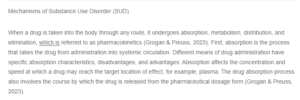Peer Response- Mechanisms of Substance Use Disorder (SUD)
Responding to Peer 2
Hello,
I agree with you. Substance use during adolescence causes structural alterations of the developing brain structure, hence, its functioning and neurocognition. Exposure to substances and drugs such as alcohol during the critical neurodevelopmental window contributes to the long-term neurobiological alterations that affect receptor expression and neural function, leading to the development of mental and behavioral problems (Thorpe et al., 2020). To understand the brain and behaviors of your grandson, who is on the spectrum, it is best to understand that some of the issues affecting him are a result of his parent’s substance use. Besides, evidence has shown that substance abuse, including psychotropic drug abuse among child-bearing aged women and pregnant women, exposes unborn children to psychoactive drugs with a negative impact on their neurodevelopment (Etemadi-Aleagha & Akhgari, 2022). Further, evidence from animal models shows that substance and drug abuse alter the brain reward and stress circuits, which can be passed on to future generations, indicating early-life vulnerability to drug abuse and related drug and substance abuse disorders (Levis et al., 2022). Thus, exposure to substances and drugs, through direct or indirect use, has significant effects on the child’s neurodevelopment and increases the risk of early substance abuse and co-occurring disorders.
References
Etemadi-Aleagha, A., & Akhgari, M. (2022). Psychotropic drug abuse in pregnancy and its impact on child neurodevelopment: A review. World Journal of Clinical Pediatrics, 11(1), 1. https://doi.org/10.5409/WJCP.V11.I1.1
Levis, S. C., Baram, T. Z., & Mahler, S. V. (2022). Neurodevelopmental origins of substance use disorders: Evidence from animal models of early-life adversity and addiction. European Journal of Neuroscience, 55(9–10), 2170–2195. https://doi.org/10.1111/EJN.15223
Thorpe, H. H. A., Hamidullah, S., Jenkins, B. W., & Khokhar, J. Y. (2020). Adolescent neurodevelopment and substance use: Receptor expression and behavioral consequences. Pharmacology & Therapeutics, 206, 107431. https://doi.org/10.1016/
ORDER A PLAGIARISM-FREE PAPER HERE
We’ll write everything from scratch
Question
Mechanisms of Substance Use Disorder (SUD)
When a drug is taken into the body through any route, it undergoes absorption, metabolism, distribution, and elimination, which is referred to as pharmacokinetics (Grogan & Preuss, 2023). First, absorption is the process that takes the drug from administration into systemic circulation. Different means of drug administration have specific absorption characteristics, disadvantages, and advantages. Absorption affects the concentration and speed at which a drug may reach the target location of effect, for example, plasma. The drug absorption process also involves the course by which the drug is released from the pharmaceutical dosage form (Grogan & Preuss, 2023).

Peer Response- Mechanisms of Substance Use Disorder (SUD)
Secondly, drug metabolism is the breakdown of the drug by the body into consequent compounds. Most of the time, metabolism involves converting the drug into water-soluble substances that will continue to renal clearance or conversion of the drug into metabolites that are active, for instance, in prodrugs such as codeine. Different metabolism mechanisms may take place in many areas throughout the body, like the skin, plasma, kidneys, and lungs, but most metabolism occurs in the liver (Grogan & Preuss, 2023).
Thirdly, drug distribution is a description of how a substance is spread all over the body. Distribution is dependent on the drug’s biochemical properties and the physiology of the individual the medication is being administered. Distribution aims to get effective drug concentration at the designated drug receptor site. The effectiveness of a drug is to reach the intended compartmental destination based on the volume of distribution rather than being protein-bound (Grogan & Preuss, 2023).
Lastly, elimination is the process of excreting the drug from the body. Most drugs are eliminated through the kidney, but some are eliminated by the skin, lungs, or gastrointestinal tract. Hydrophilic drugs are directly eliminated without the need for metabolic changes to their structure, but hydrophobic drugs must undergo modification to make them more polar. Garza et al. (2023) note that factors affecting elimination include genetic variation, drug properties, diseases, and drug distribution pathways.

